The most eccentric attraction in every US state
The Unconventional States of America
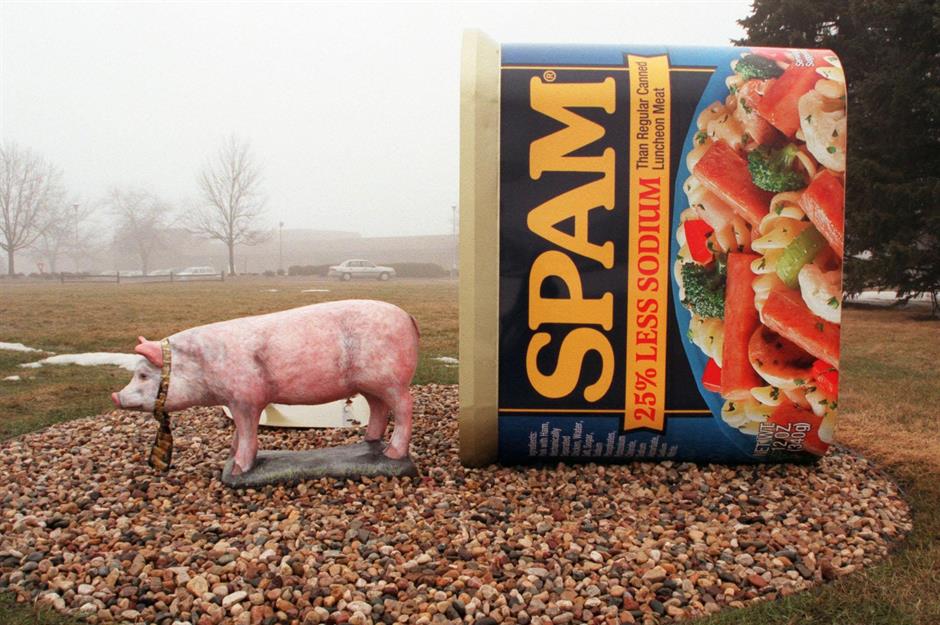
The USA is known for its roadside attractions and museums devoted to the strange and wonderful. Some take themselves seriously; others are created with tongue firmly in cheek. But nearly all of them reveal something about the unique character of the place they call home. We've picked the most unusual attraction in every state and ranked them by eccentricity.
Read on to discover which quirky attraction made it to our number one spot...
50. South Dakota: Giant Prairie Dog, Philip
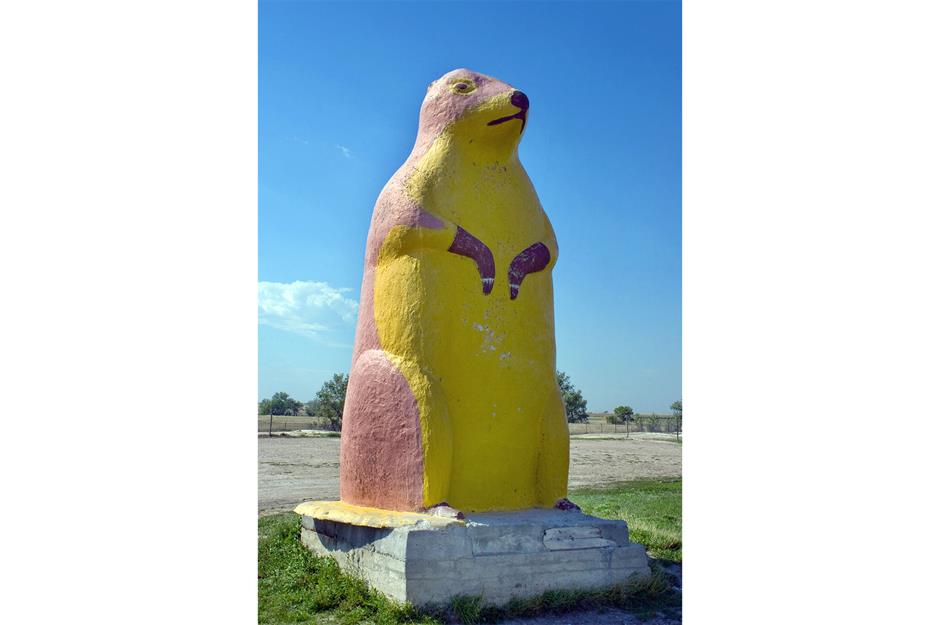
Yes, that is a six-ton, 12-foot-tall concrete prairie dog sitting just outside of the Badland National Park in Philip, South Dakota. The massive statue has been watching over this corner of the Badlands for more than 50 years, and is purportedly the largest in the world.
Visiting it is free, but for only $1 you can buy peanuts from the adjoining Ranch Store Gift Shop and make friends with the life-size prairie dogs, who scurry around the place.
49. Wyoming: National Museum of Wildlife Art, Jackson
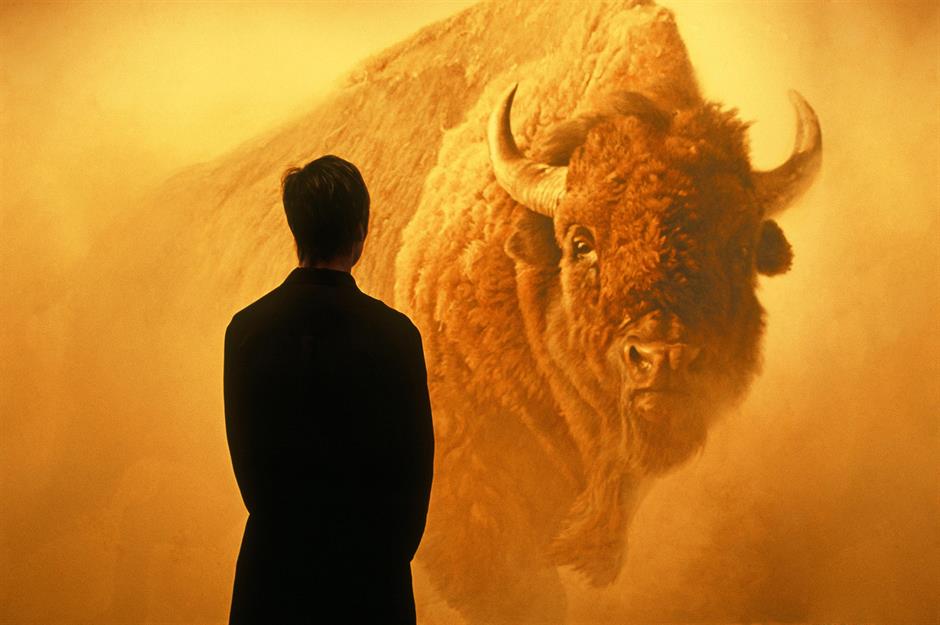
Reportedly inspired by the ruins of Slains Castle in Scotland, the National Museum of Wildlife Art, built into the side of a cliff in Jackson, houses one of the largest collections of wildlife art in the US.
It has amassed over 5,000 pieces of wildlife-inspired art, from Native American bird stones that are more than 2,500 years old, to paintings and sculptures from modern masters.
48. Washington: Rubber Chicken Museum, Seattle

Even if you’ve never found rubber chickens particularly funny, you can’t help but admire Archie McPhee’s dedication to this brightly colored comedy prop. Archie runs the popular Archie McPhee novelty store in Seattle and has turned a whole section of the store into a Rubber Chicken Museum.
Here you’ll find dozens of bright yellow birds peering out from display cases with their beaks agape. It’s guaranteed to raise a smile, even if it’s a rueful one accompanied by a shake of the head.
47. New York: TWA Flight Center at JFK Airport, Queens
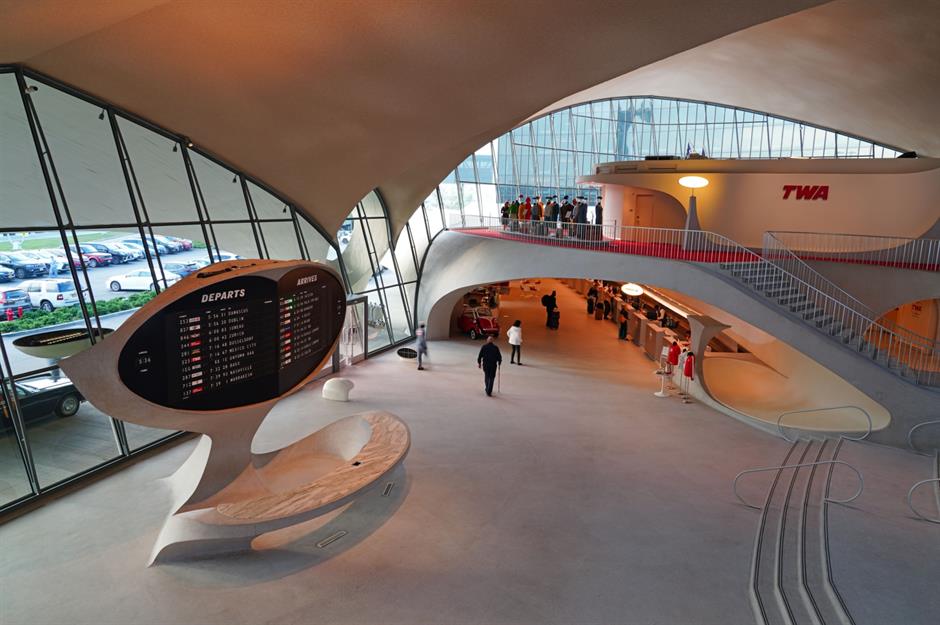
If the TV series Mad Men was an airport hotel, this would be it. Formerly the TWA Flight Center, this futuristic airport terminal was the last word in sophisticated air travel and became known as the 'Grand Central of the Jet Age.'
Sadly, all this 1960s glamor didn’t comply with modern security, and the terminal was closed in the early 2000s. 20 years later, it’s back as a retro 512-room hotel, and as stylish and beguiling as ever.
46. Texas: World’s Largest Cowboy Boots, San Antonio

In 1979, Texan artist Bob 'Daddy-O' Wade turned his skills in concrete and fiberglass to fashioning a stylish pair of 35-foot-tall ostrich-skin cowboy boots.
In 2016, the Guinness Book of Records recognized them as the largest in the world, and today they sit outside San Antonio’s North Star Mall. It seems everything really is bigger in Texas.
45. Wisconsin: The Bronze Fonz, Milwaukee

On August 19, 2008, the city of Milwaukee honored one of its most beloved fictional sons, with a bronze statue bearing his likeness on North Riverwalk Way.
Arthur Fonzarelli, aka The Fonz, was a character on the popular TV series Happy Days that ran from 1974-1984, set in Milwaukee. He was played by Henry Winkler (pictured, with his sons) and said things like “Heeyyy!” and "Sit on it.”
Love this? Follow our Facebook page for more travel inspiration
44. North Dakota: World’s Largest Buffalo, Jamestown
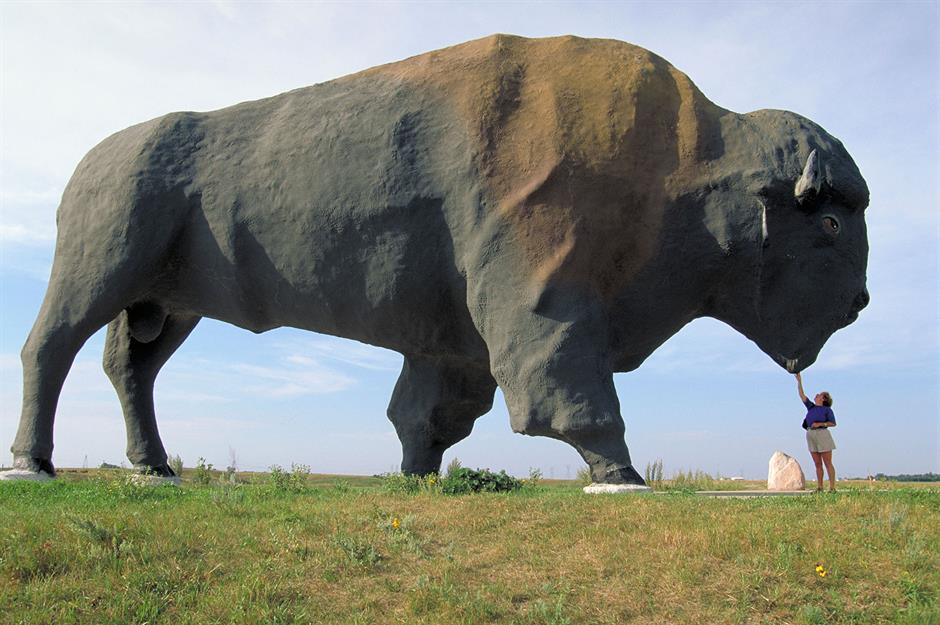
Standing on the same plains near Jamestown where herds of wild buffalo once roamed freely, this massive roadside sculpture is a sad but majestic reminder of what once was. It's 46 feet long, 26 feet in height, and weighs 60 tons – the equivalent of 60 full grown male buffalo.
Stop for a photo, by all means, but be sure to check out the live herd of buffalo living nearby, including the extremely rare albino buffalo.
43. Rhode Island: Rhode Island Red Monument, Little Compton
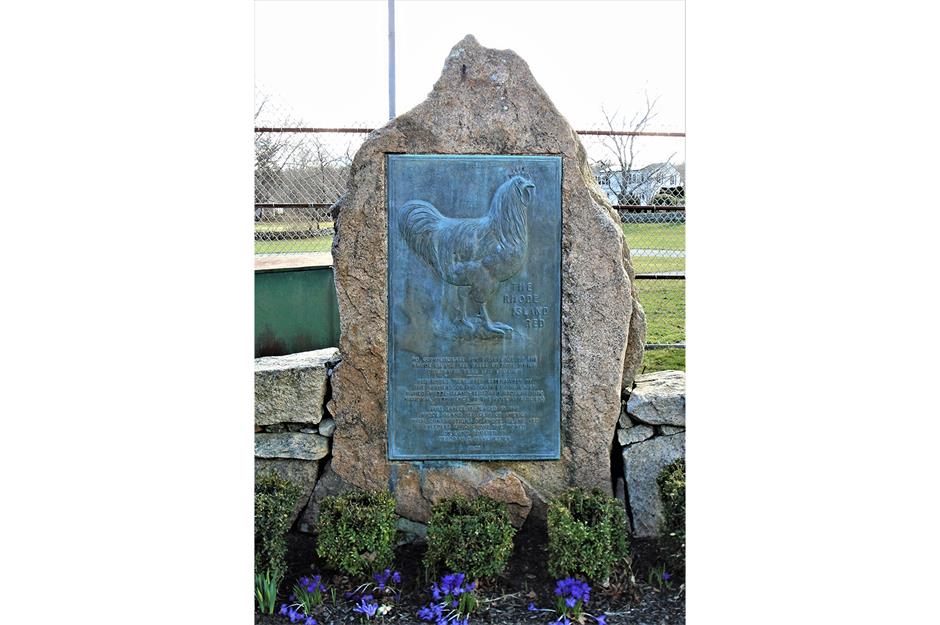
Attractions don’t get much more eccentric than this – a rough-hewn granite monument with a bronze tablet bearing the likeness of a large chicken, next to a baseball field in a small hamlet in Rhode Island.
It is, of course, a tribute to Rhode Island's state bird, the Rhode Island Red, a domesticated chicken breed that absolutely dominated the 19th-century poultry industry. It was erected in 1925 to mark the spot where the breed originated and was added to the National Register of Historic Places in 2001.
42. Iowa: American Gothic Barn, Mount Vernon
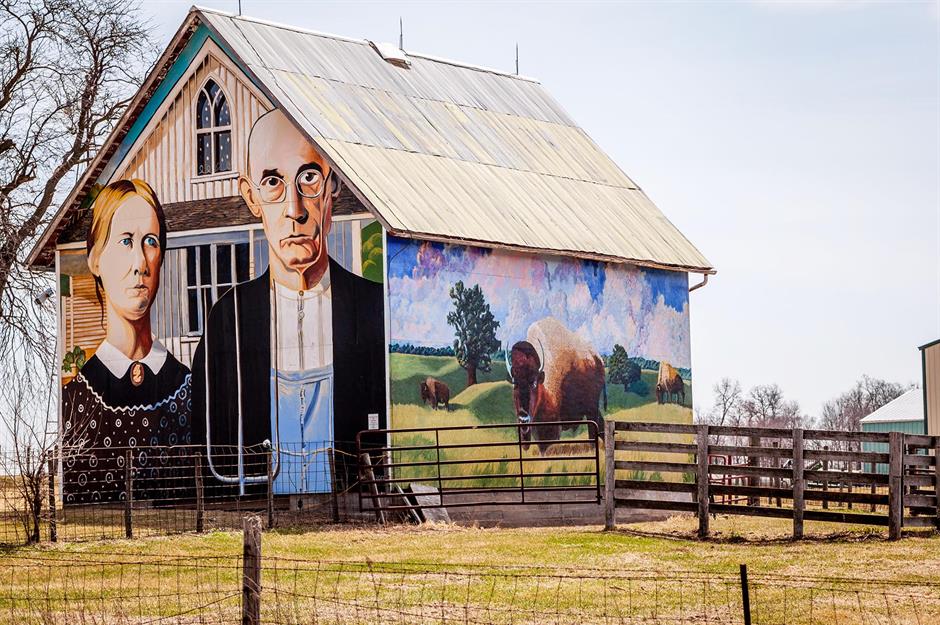
Grant Wood’s famous painting American Gothic is one of the most recognizable and best loved works of art in modern America. One farmer in Mount Vernon, Iowa took his love of the painting to extraordinary lengths by commissioning the local middle school art teacher to create a super-sized reproduction on the side of his barn.
You’ll spot it on the left-hand side, through a stand of trees, as you make your way along Route 30 from Cedar Rapids.
41. Illinois: Obama Kissing Rock, Chicago

In the summer of 1989, the future President of the United States, Barack Obama, took future First Lady Michelle Obama on their first date at a Baskin-Robbins in the Hyde Park neighborhood of Chicago.
They ate their ice cream on the curb opposite, on the corner of Dorchester and 53rd Streets. They also shared their first kiss, an occasion memorialized by this plaque attached to a 3,000-pound boulder.
40. Oklahoma: American Banjo Museum, Oklahoma City
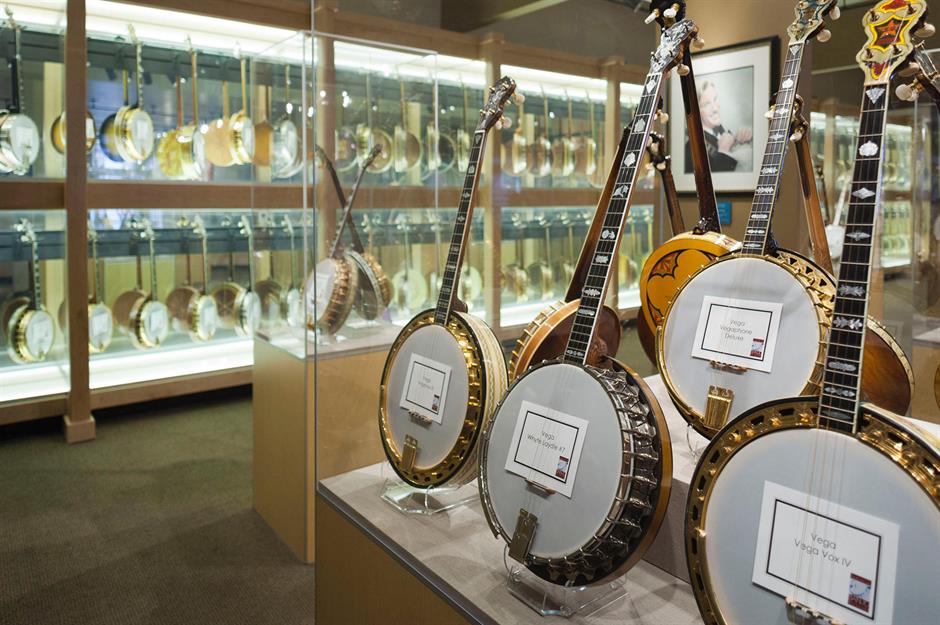
Considered the most American of instruments, the banjo was actually appropriated from African enslaved people who made the instruments using gourds and animal skin.
The American Banjo Museum in Oklahoma City recognizes this plus hundreds of other interesting facts and stories in a display of over 400 instruments, as well as historic sheet music, related ephemera, and out-of-print records from forgotten banjo greats.
39. Pennsylvania: Rocky Statue, Philadelphia
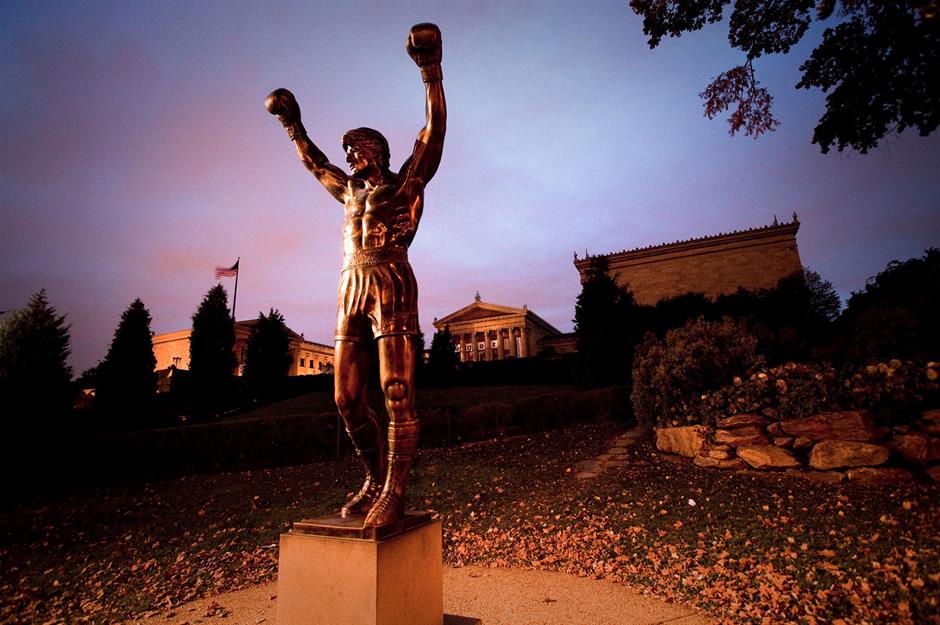
In a city bursting with world-class museums and galleries, one piece of public art draws more visitors than most in Philadelphia – a cast bronze statue of Rocky Balboa at the bottom of the steps leading to the Philadelphia Museum of Art. Rocky, of course, is the character played by Sylvester Stallone in the (many) Rocky movies.
And the 72 steps leading up to the museum have become known as ‘The Rocky Steps’ after the iconic training scene in the first movie. The statue was created by A. Thomas Schomberg and commissioned by Stallone himself.
38. West Virginia: Big Apple Time Capsule, Martinsburg
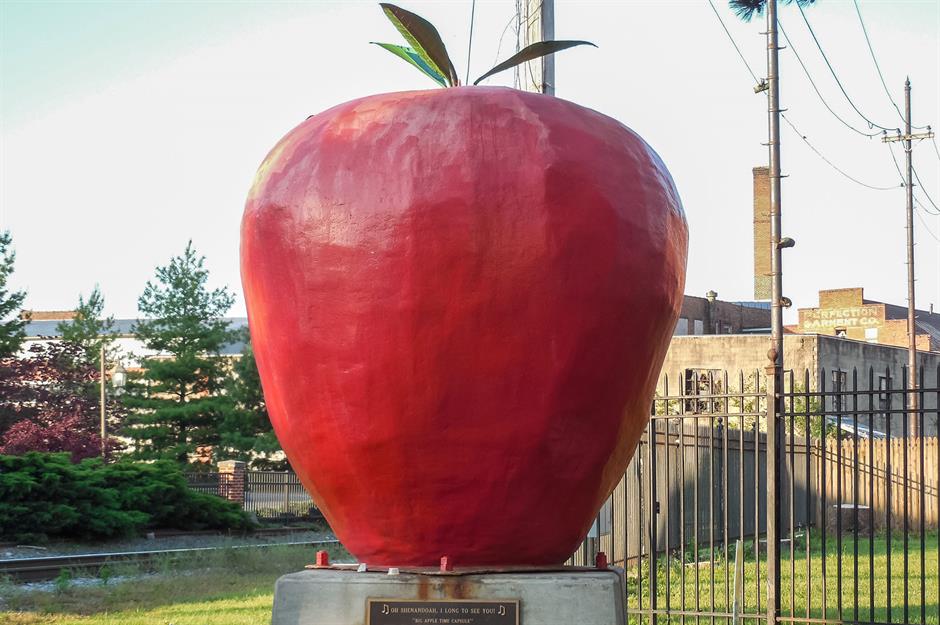
Created as a Community Pride Project in 1990, this giant fiberglass apple in Martinsburg, West Virginia is not just another 'big thing' celebrating the area’s legacy of apple farming.
It’s a time capsule too, scheduled to be opened in 2040 and full of artifacts to give future Martinsburg residents a fascinating insight into life in the 1990s – when people ate apples plucked from a tree rather than in a vacuum-sealed space pouch (maybe).
37. Mississippi: The Crossroads, Clarksdale

Did the legendary blues musician Robert Johnson meet the devil at the intersection of 61 and 49 in Clarksdale? Did Lucifer then tune his guitar and bestow him with otherworldly talent in exchange for his soul?
We’ll never know, of course. But the exact spot where the transaction supposedly took place is marked with three giant blue guitars and called The Crossroads. It remains one of the most popular attractions on the Blues Trail in Mississippi.
36. Alabama: Peanuts on Parade, Dothan
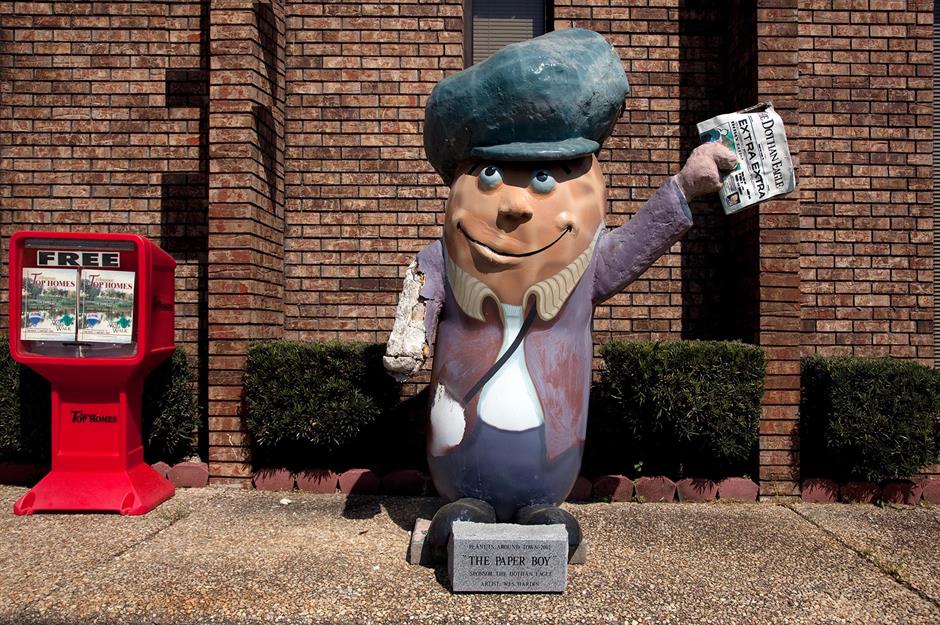
Dothan is the self-proclaimed 'Peanut Capital of the World.' Half of the peanuts produced in the US are grown within a 100-mile radius of the city center. They celebrate with an annual Peanut Festival every fall, of course, but local non-profit coalition The Downtown Group wanted the city’s peanut credentials to be honored throughout the year.
Fiberglass peanuts were given to local artists who were told to let their imaginations go wild. The result is Peanuts on Parade, over 60 anthropomorphic peanuts dotted around the town celebrating local businesses, services, and awareness programs.
35. Alaska: Hammer Museum, Haines
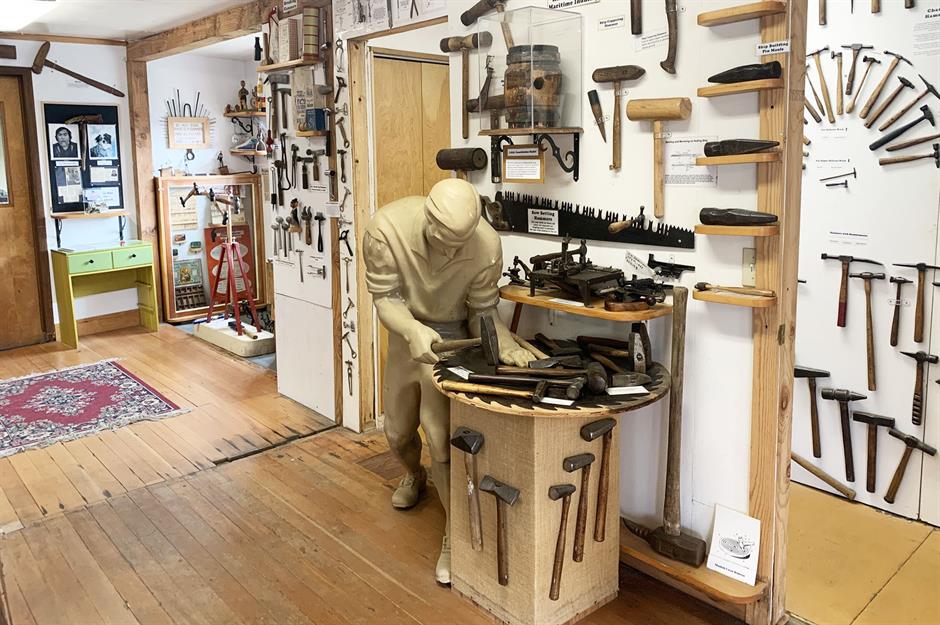
Dave Pahl has always had a bit of a thing for hammers. In 2001, after years of collecting and repairing old tools, he opened the Hammer Museum on the Alaska Panhandle in Haines.
The museum is easy to spot – there’s a giant hammer outside – and holds a collection of over 2,000 pieces including ancient Egyptian hammers and ones designed specifically to test cheese. The prize exhibit is a Tlingit warrior's hammer, thought to be at least 800 years old, and uncovered when Dave was building the museum.
34. Tennessee: Titanic Museum Attraction, Pigeon Forge

Travelers passing through Pigeon Forge in Tennessee’s Smoky Mountains are greeted by an unusual sight – a half-scale recreation of the doomed ocean liner Titanic, crashing into a half-scale recreation of the iceberg that sank it.
Opened in 2010, and costing $25 million to build, the Titanic Museum Attraction also includes recreations of the ship’s rooms based on actual Titanic blueprints. There is even an interactive exhibition where you can touch ice water at the exact temperature that the unfortunate souls were plunged into in 1912.
33. Connecticut: Frog Bridge, Willimantic

The small city of Willimantic in Connecticut is famous for two things. The cotton mill that once cranked out 50,000 spools of thread a week in the early 1900s. And the ‘Battle of the Frogs’, when a huge, loud racket in the woods in 1754 convinced the townsfolk they were under attack from the French.
The noise turned out to be thousands of bullfrogs fighting over what was left of a drought-ravaged pond. So when a new bridge was built in 2001, locals insisted it featured a giant bronze frog. Atop an equally large spool of thread, of course.
32. Delaware: Steampunk Treehouse, Milton
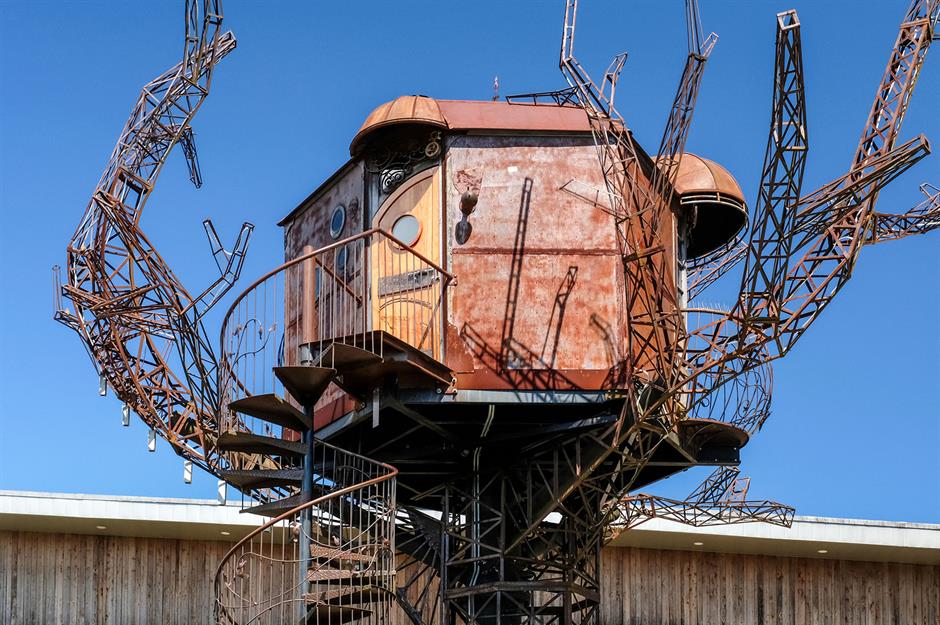
If the chance to sample a craft beer at the Dogfish Head brewery in Milton doesn’t entice passing visitors to stop, the sight of a giant metallic treehouse often does.
Created for the Burning Man Festival in 2007 by artist Sean Orlando and the Five Ton Crane Collective, the 40-foot tree fashioned from welded girders and metal plates sits juxtaposed against the hi-tech fermenting tanks behind it.
31. South Carolina: Neverbust Chain, Columbia
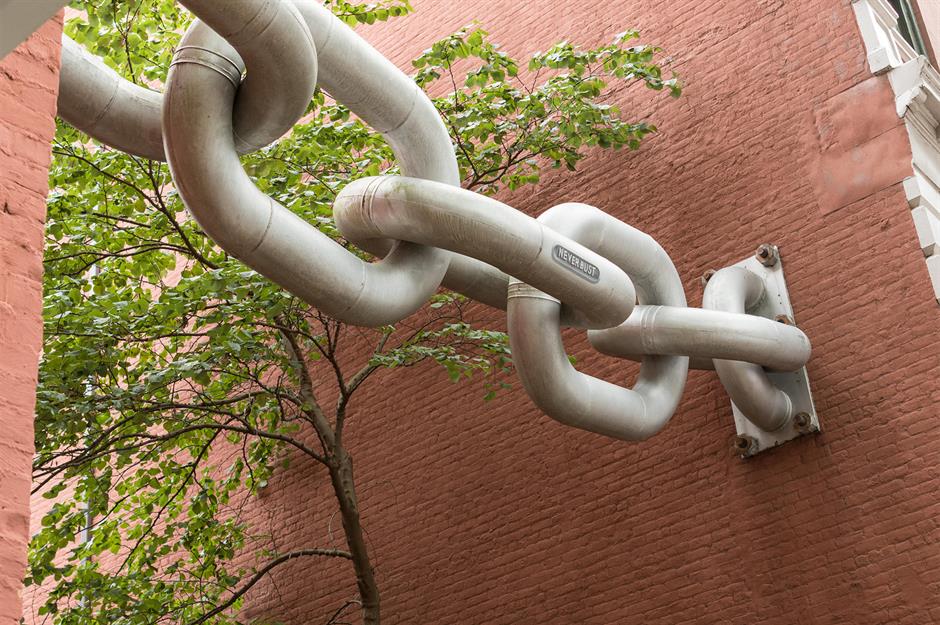
The seriously chunky Neverbust Chain that links two large office buildings in downtown Columbia is the work of local artist Blue Sky (formally Warren Edward Johnson). And while it may look too large to be real, those links really are made of steel.
As the chain spans 10 feet over a public alley it was professionally welded together for the sake of safety. And the reason behind the work? Apparently the artist thought one of the buildings 'looked like it was leaning a little bit'.
30. Florida: City of Live Mermaids, Weeki Wachee

The City of Live Mermaids in Weeki Wachee Springs State Park has been enchanting visitors of all ages since it opened in 1947. Glamorous ‘mermaids’ swim and dance in an underwater theater built 20 feet below the spring’s crystal-clear surface, using special breathing techniques developed by former Navy man Newton Perry.
The park offers all kinds of other adventures too, like kayaking and special seasonal events, but it is the siren call of the mermaids that keeps people coming back.
29. Hawaii: Ka’a’awa Valley Film Lot, Oahu
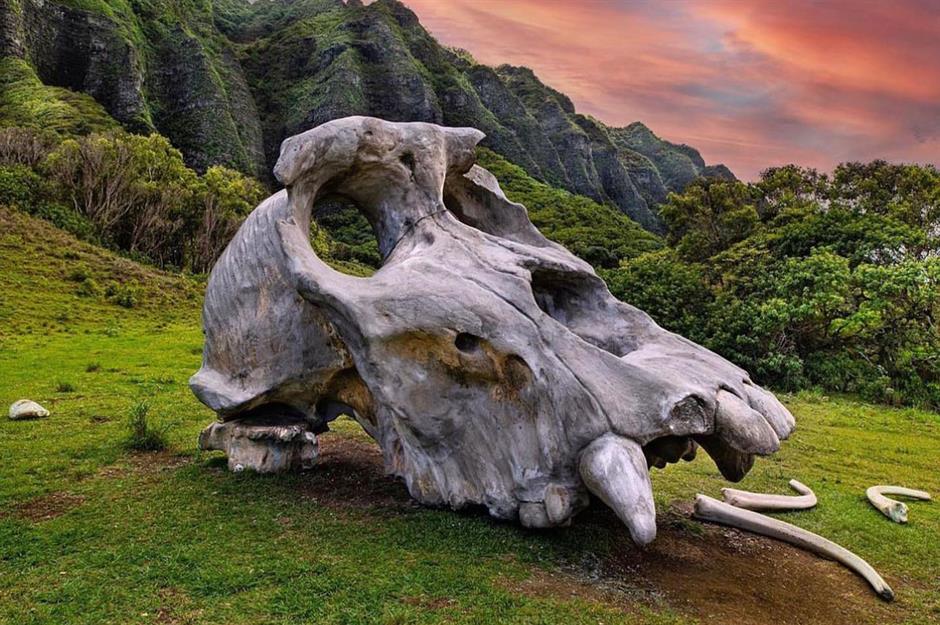
This is your chance to walk among the dinosaurs – or at least a realistic representation of their bones – in the breathtaking Ka’a’awa Valley. Part of the privately-owned Kualoa Ranch, this is where much of Jurassic Park was shot, as well as King Kong, and more recently the Jumanji movies.
Today the ranch offers tours of the most famous movie sites in the valley, including a field scattered with dinosaur bones and a mountain-side World War II bunker that now hosts posters and props from over 200 titles that have been shot here.
28. Arizona: Rattlesnake Bridge, Tucson
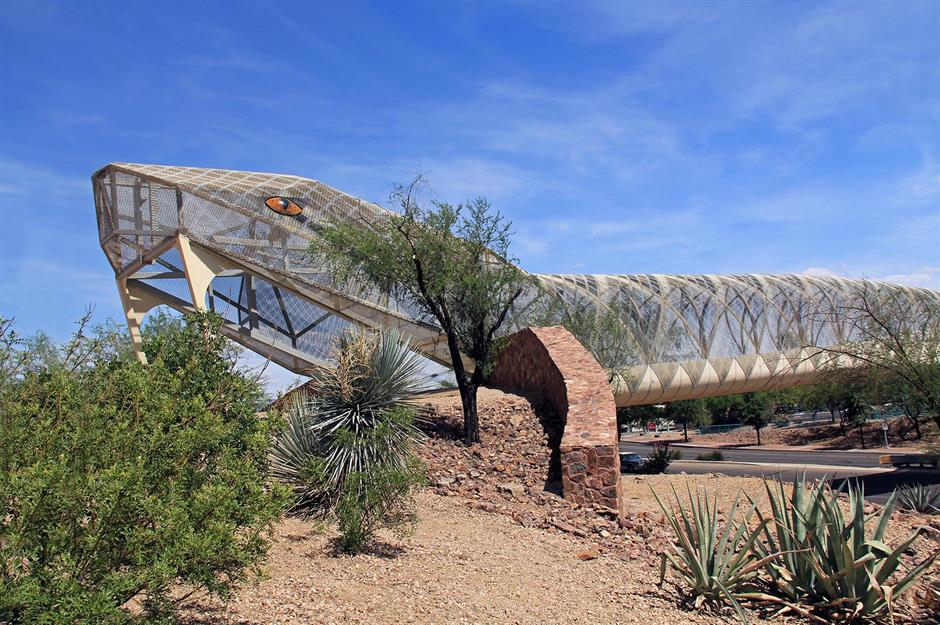
Tucson has a reputation for combining public art with city improvement projects. And nowhere is that more apparent than the bicycle and pedestrian bridge over Broadway Boulevard at the Barraza-Aviation Parkway.
Designed by artist Simon Donovan, it is built in the shape of a giant diamondback rattlesnake, offering the unnerving experience of entering its gaping maw, complete with fangs, to get to the other side. Locals were unsure at first, but the bridge has since been recognized as one of the nation's best road projects by the Federal Highway Administration.
27. Missouri: National Cookie Cutter Historical Museum, Joplin
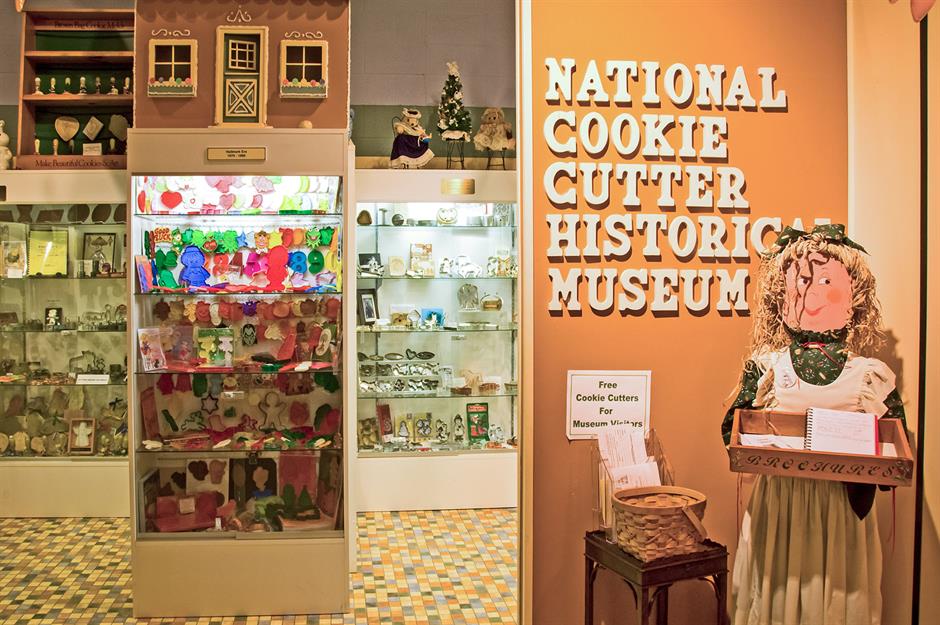
Everyone knows that cookies taste better when cut into whimsical shapes. And this equally whimsical museum in Joplin, Missouri is dedicated to the tool that does just that – the humble cookie cutter.
Tin cookie cutters were brought to the New World from Europe and quickly became a holiday season necessity, cutting out cookies in the shape of trees, pumpkins, horses, and more. The National Cookie Cutter Historical Museum traces that history through dozens of display cases stuffed with cutters, with each visitor receiving a free plastic cookie cutter to take home with them.
26. Idaho: Museum of Clean, Pocatello

If you think cleanliness is next to godliness then you’ll find this museum in southeastern Idaho, dedicated to the history and art of staying clean, absolutely heavenly. The Museum of Clean was founded in 2006 by Don Aslett to display his personal collection of cleaning supplies, including 250 pre-electric vacuums.
A doyen of the cleaning industry, Don has written books and delivered lectures about cleanliness, and hopes the museum will help spread his belief that the concept of clean is about more than just dirt and clutter; it’s a way of life.
25. Indiana: Indiana Medical History Museum, Indianapolis
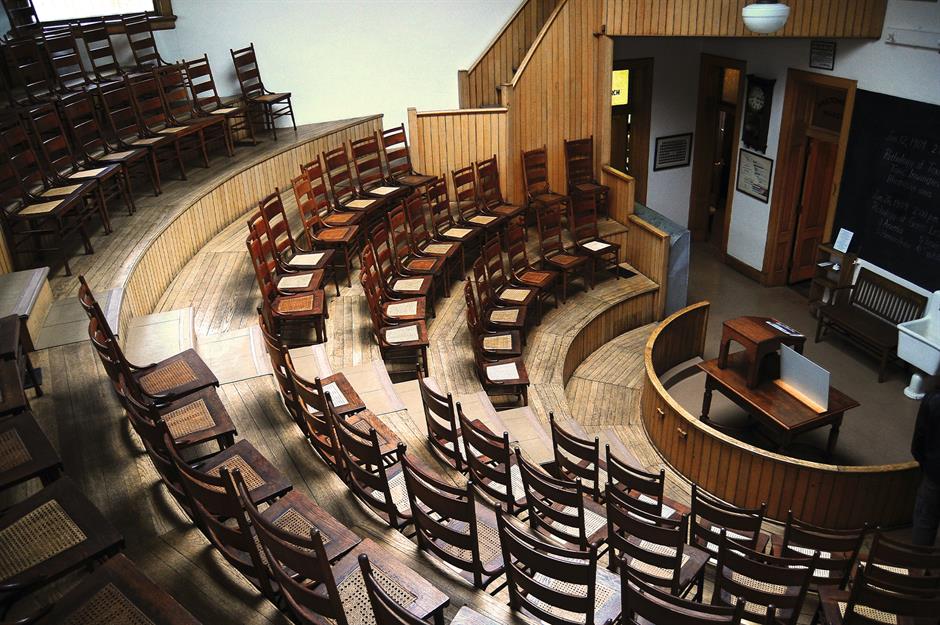
The Indiana Medical History Museum sits in the old pathology building of the psychiatric Central State Hospital. It is like a time capsule, a perfectly preserved and untouched medical facility from the late 19th and early 20th century.
The 1896 teaching amphitheater is exactly as it was when students and doctors watched autopsies. And the array of gleaming instruments are an intriguing insight into how much medicine has changed. It can only be viewed on a guided tour, but you’re free to wander the beautiful medicinal garden in spring and summer.
24. Maine: Wild Blueberry Land, Columbia Falls

Wild blueberries are one of only three fruits native to the United States, and the official fruit of Maine. Just off Route 1 in Columbia Falls, you’ll find Wild Blueberry Land, a theme park and farm dedicated to celebrating this humble food.
Apart from the farm where the wild blueberries grow, the main attraction is a bakery housed in a bright blue geodesic dome, offering freshly baked blueberry pastries, breads, and sweets. There’s a blueberry-themed mini-golf course as well, with winners offered the pick of fresh veggies grown on the farm as their prize.
23. Maryland: Decoy Museum, Havre de Grace
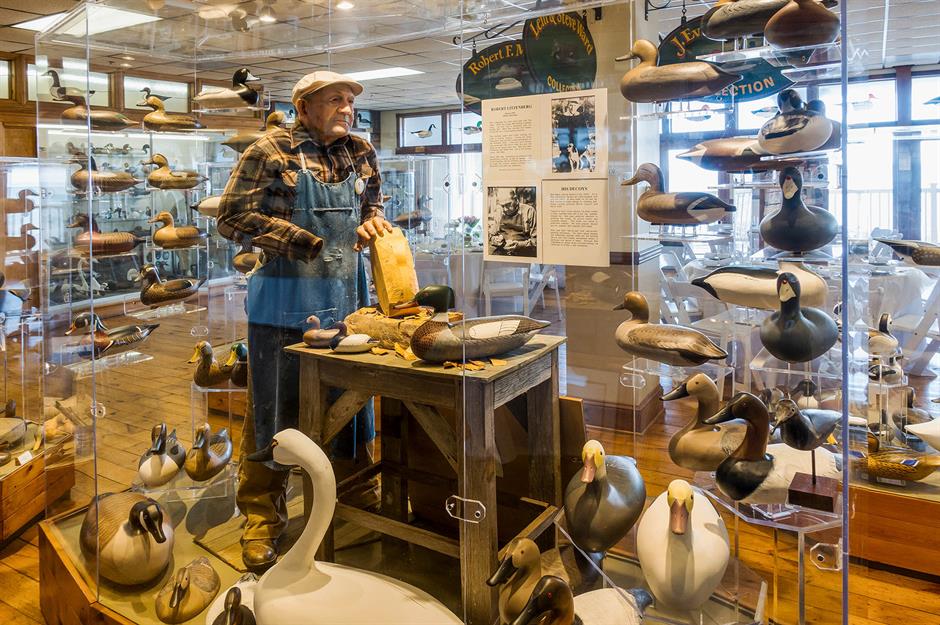
On the banks of the historic Susquehanna Flats in Maryland you’ll find the Havre de Grace Decoy Museum. Decoys have been a central element of Chesapeake culture for centuries, not just as utilitarian objects but as works of art as well.
The museum has over 1,200 decoys on display, including extraordinary decorative carvings by masters such as R. Madison Mitchell, Bob McGaw, and the Ward Brothers. Just don’t call them fakes. These are sophisticated works of art created with century-old skills passed down from master to apprentice for generations.
22. California: Salvation Mountain, Calipatria
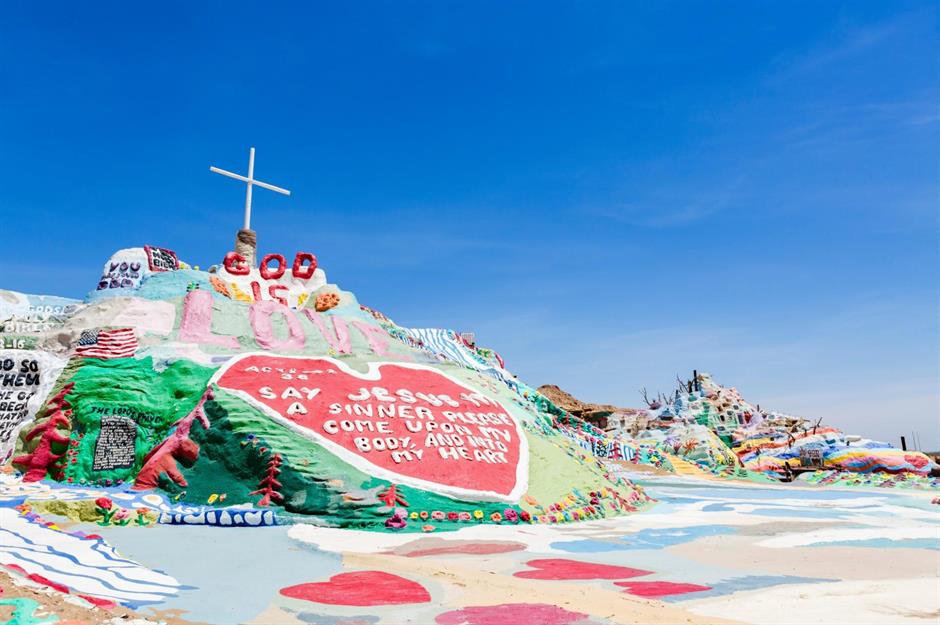
Salvation Mountain in Calipatria rises like a psychedelic mirage in California's Colorado Desert. It’s the work of local artist Leonard Knight who built the 50-foot-high mound from adobe mud and straw in 1985.
Knight spent the next 30 years covering it with folk art proclaiming his religious devotion, drawing tourists to a part of southern California that had fallen upon hard times. Knight sadly passed away in 2014, but other local artists have taken it upon themselves to maintain his labor of love and see its legacy continue.
21. Massachusetts: Museum of Bad Art, Boston

The MOBA (Museum of Bad Art) started after its founder Scott Wilson pulled the gallery’s first piece out of a trash heap. He dubbed it Lucy in the Field with Flowers, and it has since been joined by hundreds of equally horrific masterpieces, like this one, Torment of the Soul, bought in a thrift store. Originally housed in the Dedham Community Theater, the collection has now moved to the Dorchester Brewing Company.
20. Montana: Jim’s Horn House, Three Forks
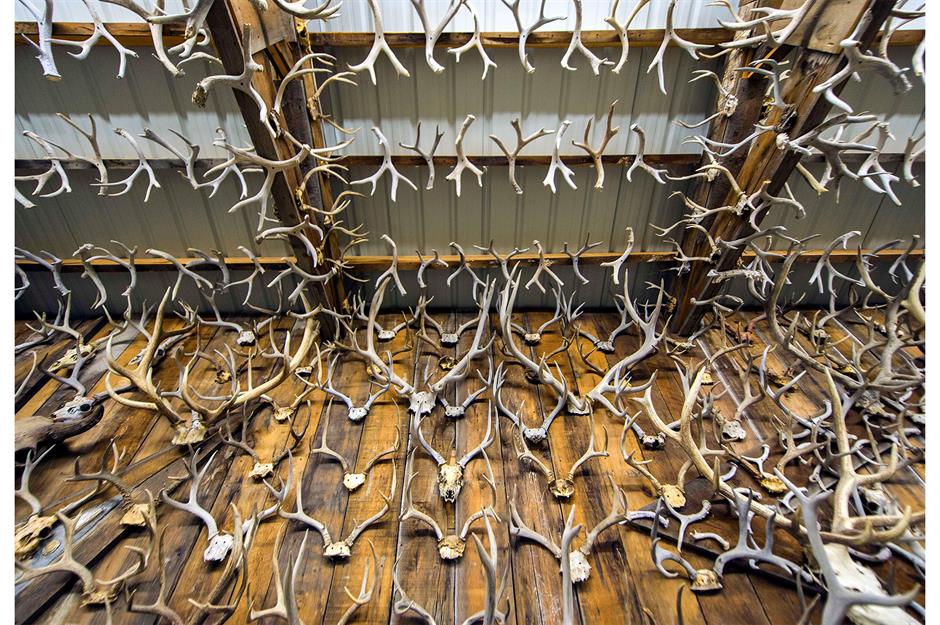
Jim Phillips began collecting antlers as a 10-year-old boy, and over the decades has amassed a collection of over 16,000, most found on hikes into the Montana backcountry. Now the 'Antler Man’ displays his extraordinary collection in a well-lit shed in Three Forks, Montana for the whole world to admire.
19. New Hampshire: Museum of Dumb Guy Stuff, Portsmouth
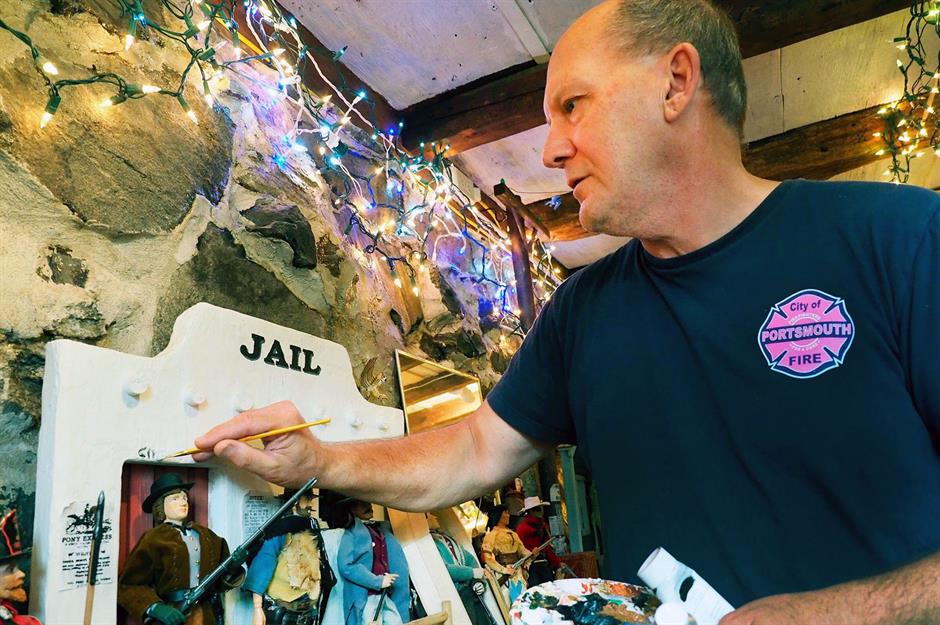
How you feel about the Museum of Dumb Guy Stuff in Portsmouth, New Hampshire will depend on how you consider the ‘treasures’ it holds. Is curator Clayton Emery’s shrine to his boyhood toys from the 1960s simply dumb guy-stuff, or is it a fun nostalgia trip?
This is the fundamental question you need to ask as you wander through his eccentric collection housed in the basement of his Mechanic Street home.
18. New Jersey: Fluorescent Rocks of Sterling Hill Mine, Ogdensburg

Don’t be concerned by the colorful glow as you approach the Sterling Hill Mine Museum. This historic zinc mine in New Jersey is now home to the largest publicly displayed collection of fluorescent rocks in the world.
In 1990, brothers Richard and Robert Hauck filled the abandoned mine with fluorescent minerals, fossils, crystals, glass, fabric, and concrete and then fitted ultraviolet lights to showcase their glowing qualities. It is arguably the most surreal sight in northern New Jersey.
17. New Mexico: Johnnie Meier Classical Gas Museum, Embudo

As is often the way with eccentric attractions in the US, the Classical Gas Museum in Embudo, New Mexico grew out of one man’s singular passion. Johnnie Meier began collecting gas station paraphernalia after he retired and a decade or so later he opened the museum in his home beside the Rio Grande.
Just look for the impressive line of old gas pumps on the south side of NM route 68. But make sure to fill up before you arrive – not one of them still pumps gas.
16. Ohio: As We Are sculpture, Columbus

At any convention held at the Greater Columbus Convention, the longest line isn’t at the café or to chat with a highly regarded guest speaker. Rather, it’s in the North Atrium, where visiting delegates line up to get their picture taken inside a sculpture called As We Are.
Known locally as 'the giant head', the 14-foot LED sculpture has a photo booth in the neck where you can have a 3D picture taken that is then displayed on the sculpture’s face. The work of artist Matthew Mohr, it has taken the concept of selfies to a whole new level.
15. Nevada: Clown Motel, Tonopah
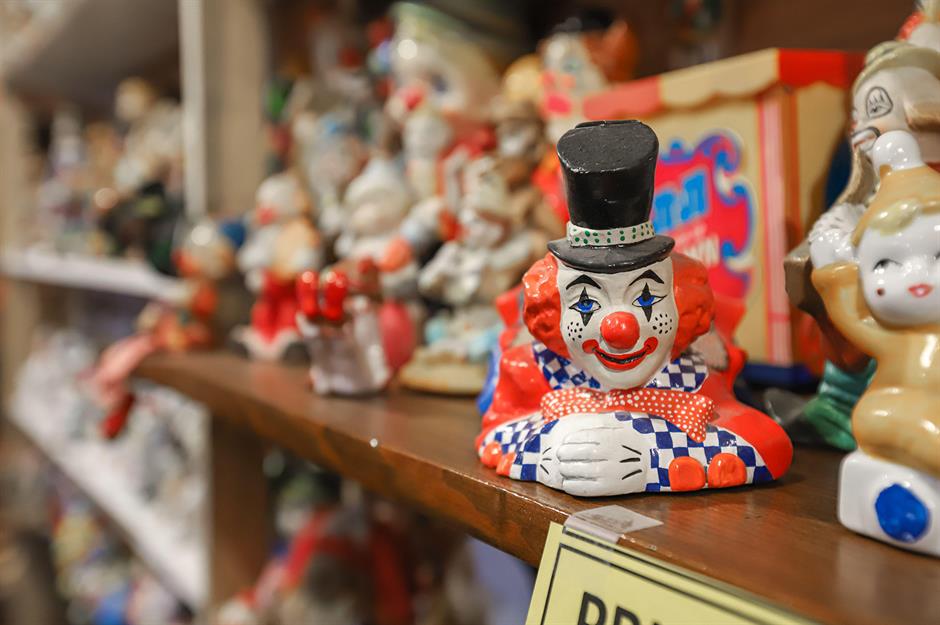
If you suffer from coulrophobia (a fear of clowns), give the Clown Motel in the desert town of Tonopah a miss. Catering to bikers, truckers, and other long-haul travelers who are mistakenly looking for a good night’s sleep, the hotel is decorated with over 3,000 clowns.
In case that isn’t scary enough, there’s a reportedly haunted Wild West cemetery just on the other side of the parking lot.
14. North Carolina: The Last Shell Oil Clamshell Station, Winston-Salem
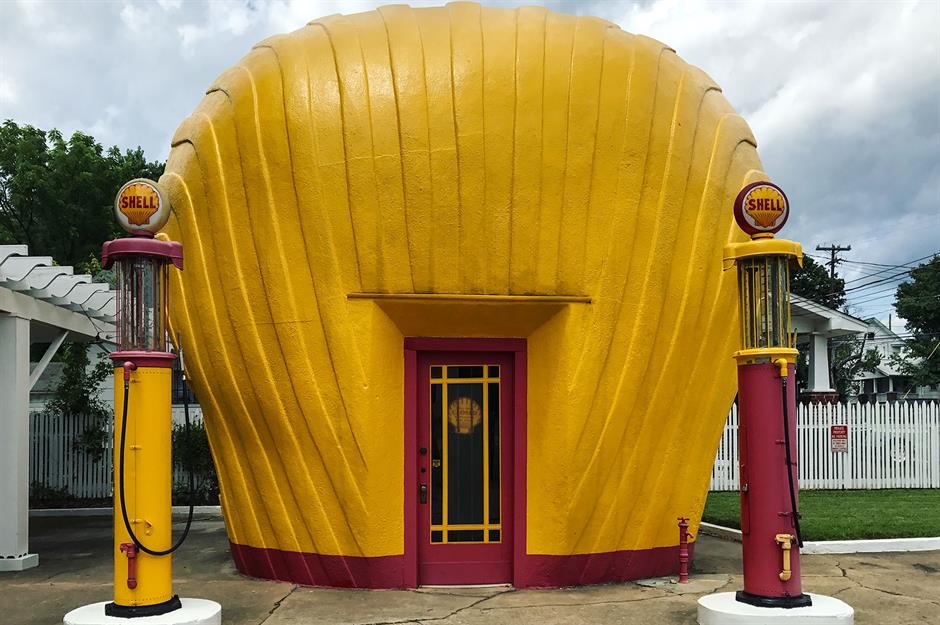
How do you stop potential customers from choosing your competitor’s gas station in 1930s North Carolina? Build your station in the shape of giant yellow clam shells, of course.
That was the brainwave local Shell distributors Joe Glenn and Bert Bennett had, and soon their eight gas stations in and around Winston-Salem were booming. Today, only one of these quirky stations survives – at 1111 E Sprague St. It doesn’t pump gas but it is on the National Register of Historic Places.
13. Oregon: Horse rings, Portland
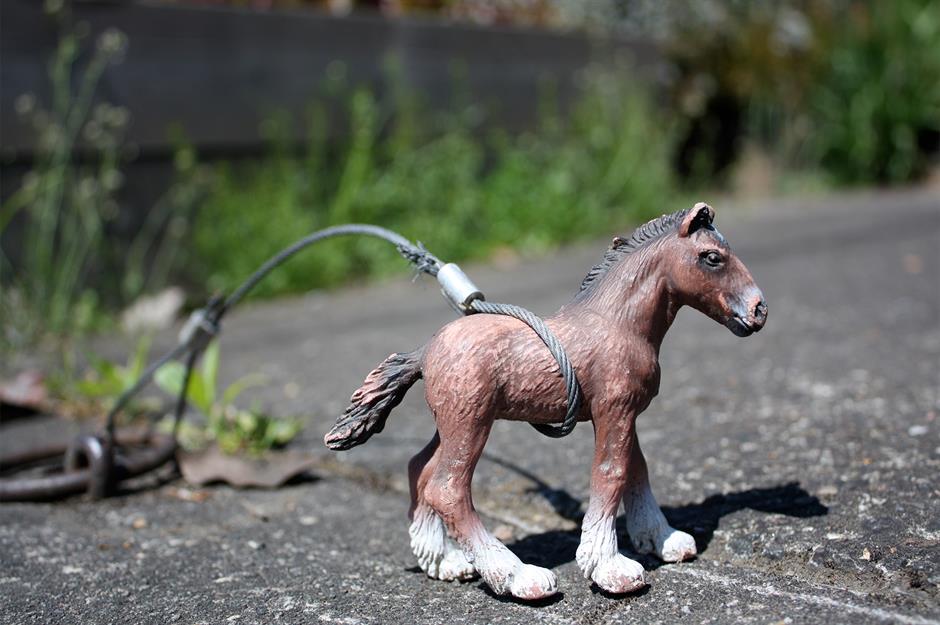
Oregon’s largest city has the slogan 'Keep Portland Weird'. The locals have certainly taken that to heart by tethering tiny plastic horses to antique rings embedded into the curb of streets around the city.
The horse rings date to the 19th and early 20th centuries, when horse-drawn carriages were the main method of transportation. When the city started removing them in 2005, local resident Scott Wayne Indiana started a campaign to save them by encouraging people to tether toy steeds to them. Now they can be seen all around Portland.
12. Utah: First Lady Dolls, Uintah County Western Heritage Museum, Vernal

In 1976, the women of Vernal in Utah came up with a novel way to celebrate America’s Bicentennial. They hired Salt Lake City sculptor Phyllis Juhlin Park to create porcelain doll heads bearing the likenesses of each of the First Ladies, from Betsy Ross all the way up to Nancy Reagan and Eleanor Roosevelt (pictured).
Inspired by dresses that each of the First Ladies wore, the dolls were put on display at the Uintah County Western Heritage Museum, where you can still see them today.
11. Virginia: American Celebration on Parade, Quicksburg

Americans love a good parade. And they have an awful lot of them. Have you ever wondered what happens to the floats after the marching band has stopped playing and the last of the ticker tape has been swept away?
Welcome to the American Celebration on Parade, part of the Shenandoah Caverns in Quicksburg, Virginia. Here you’ll find an enormous warehouse filled with parade floats from presidential inaugurals, the Rose Parade, Miss America parades, Thanksgiving Day parades, and other celebrations.
10. Arkansas: Beatles Park, Walnut Ridge
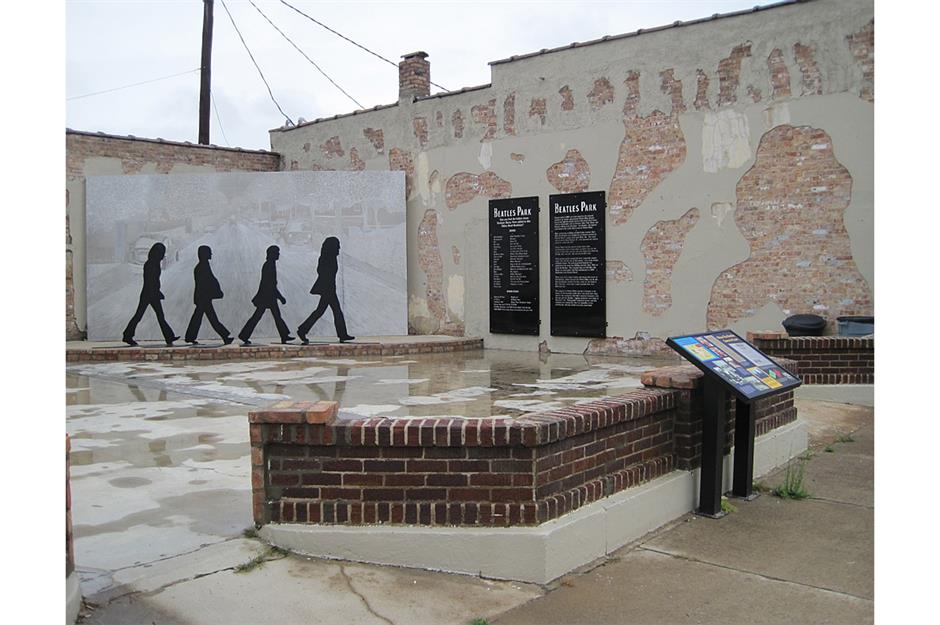
In September 1964 the Beatles landed at Walnut Ridge’s modest airport to be secretly transported to a nearby vacation spot. When word got out that they’d also be departing from there the entire town turned up to bid farewell to the Fab Four.
It was the biggest event in the tiny town’s history and they have NEVER forgotten it. A Beatles Park featuring cutouts and sculptures of the band was created in commemoration. Every September Walnut Ridge’s citizens gather there, and all over town, for a Beatles Fest featuring crafts, talks, and a live performance from an imitation band.
9. Nebraska: Carhenge, Alliance
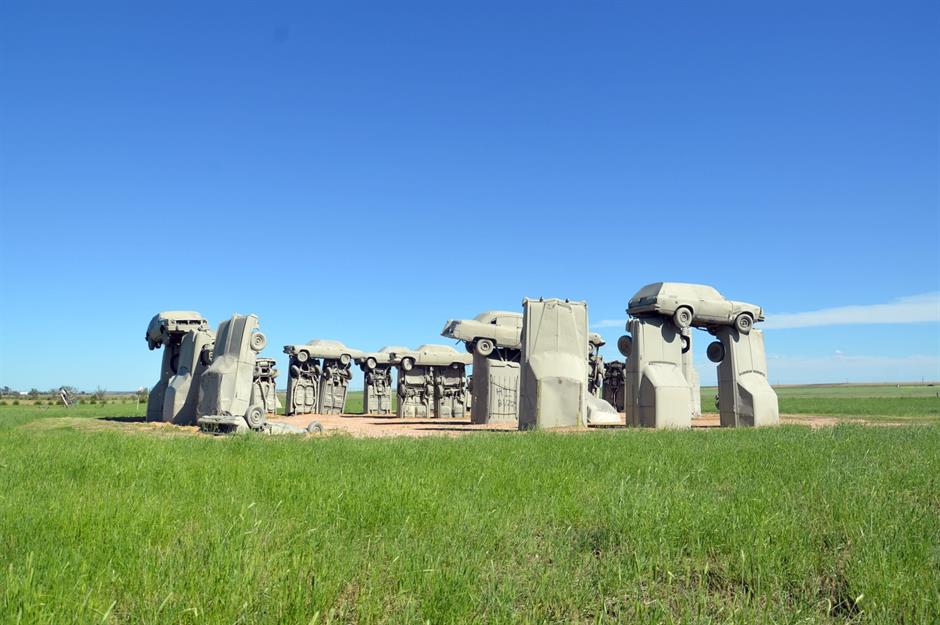
There are many ways to honor the memory of your father, but the way Jim Reinders honored his is truly unique. He made a replica of England’s prehistoric Stonehenge but by using old cars instead of stone.
38 cars represent the 38 major stones at Stonehenge and are arranged accurately and proportionately to mirror the original landmark. Each car is painted gray to match the English monument as well. The locals initially considered Carhenge something of an eyesore, but have warmed to this unconventional public art installation as its popularity has grown.
8. Kentucky: Ark Encounter, Williamstown

One can only imagine what people said to Ken Ham when he suggested building a full-size version of Noah’s Ark, but he was true to his word. Three stories high and 510 feet long, this awe-inspiring wooden vessel is now the centerpiece of Ark Encounter in Williamstown, Kentucky and one of the most highly rated attractions in the state.
Inside, sculptures of the different types of animals and animatronics of Noah and his family bring the Bible story to life.
7. Colorado: International Church of Cannabis, Denver

Whatever your feelings about Elevationism, a brand-new religion that believes rituals and the use of cannabis can reveal the best version of yourself, you’re going to want to see its spiritual headquarters in Denver, Colorado.
Once a straight-laced Lutheran church, the International Church of Cannabis on 400 S Logan Street is now a riot of color and creativity, transformed by the mind-bending murals of renowned Spanish artist Okuda San Miguel.
6. Vermont: Ben & Jerry's Flavor Graveyard, Waterbury
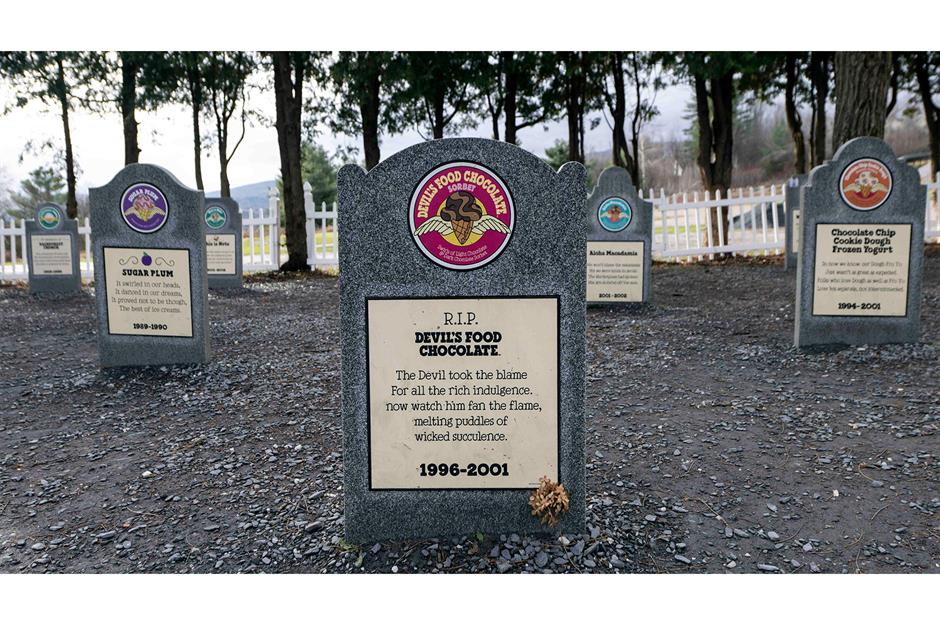
As you can imagine, the famously creative ice cream manufacturer, Ben & Jerry’s, is always coming up with new flavors. Sadly, not all of them work. But rather than consign them to the trash can of history, Ben & Jerry’s honor their failed recipes in a Flavor Graveyard at the back of their factory in Waterbury.
Here you’ll find the final resting place of Tennessee Mud, Peanut Butter and Jelly, Rainforest Crunch, and Turtle Soup, with poems etched in tombstones paying homage to their short stay on Earth.
5. Kansas: World's Largest Collection of Smallest Versions of Largest Things, Lucas

In the small rural community of Lucas in Kansas you’ll find a museum that has big ambitions but on a tiny scale. It’s the World’s Largest Collection of the World’s Smallest Versions of the World’s Largest Things.
It is, in essence, a love letter to the ‘big’ things that serve as roadside attractions around the United States. The curator, Erika Nelson, travels the country looking for inspiration and upon finding the world’s largest ketchup bottle or ball of yarn, promptly makes the world’s smallest version of them.
4. Louisiana: Nicholas Cage’s Pyramid Tomb, New Orleans

Known for his eccentric behavior both on and off camera, Nicholas Cage appears to want to maintain his idiosyncratic credentials in the afterlife. To the chagrin of many New Orleans residents he has purchased a bizarre pyramid mausoleum in the city’s much loved St. Louis Cemetery No. 1.
Some think it is evidence of his links to the Illuminati, while others, believing Cage to be immortal due to antique prints bearing a stunning resemblance to him, think it is here that he will eventually regenerate.
3. Georgia: Doll’s Head Trail, Atlanta
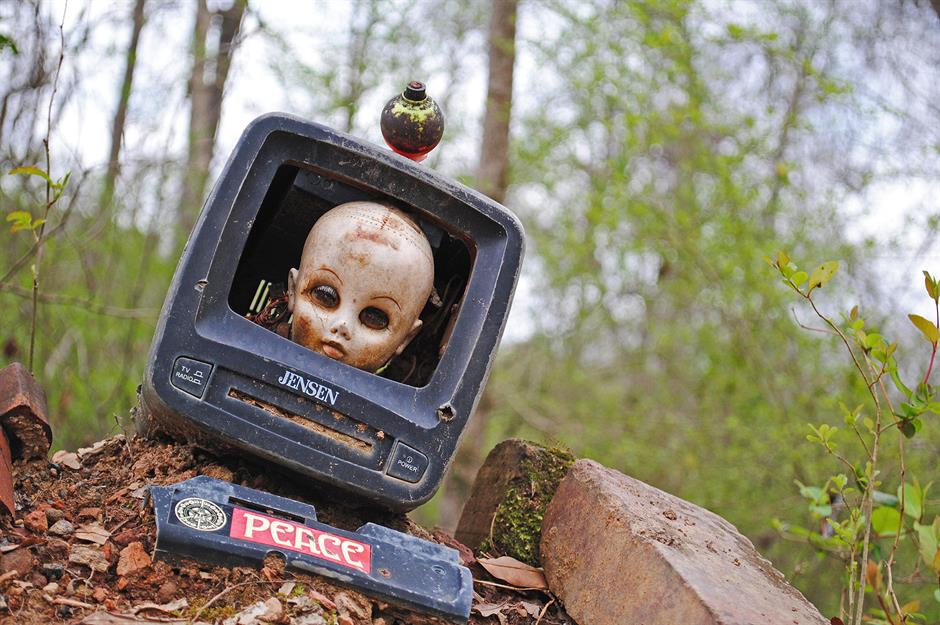
Here’s a hiking path with a difference – the Doll’s Head Trail that runs through the Constitution Lakes urban park, just a few miles from downtown Atlanta. The trail is covered in a crazy collection of outsider art, including dismembered dolls and other toys marking out the track.
Should you get lost in the woods or as you cross the wetland boardwalks on the 1.6 mile walk, simply look for a chubby plastic limb pointing you in the right direction.
2. Minnesota: SPAM Museum, Austin
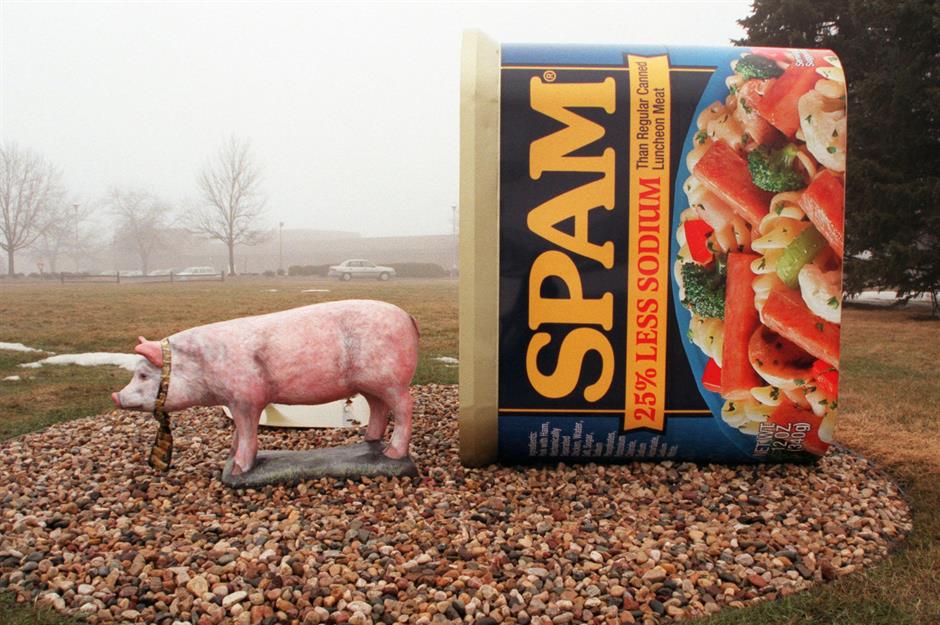
When the Hormel Foods company first introduced SPAM to the world in 1937, it could not have envisaged how internationally successful the luncheon meat made from pork (and a few other ingredients) would become.
Its success was supercharged by World War II and it remains hugely popular in places like Hawaii and the Marshall Islands because of that. This quirky museum charts SPAM’s incredible history with ‘SPAMbassadors’ on hand to share even more intriguing tales.
1. Michigan: Edison’s Last Breath, Dearborn
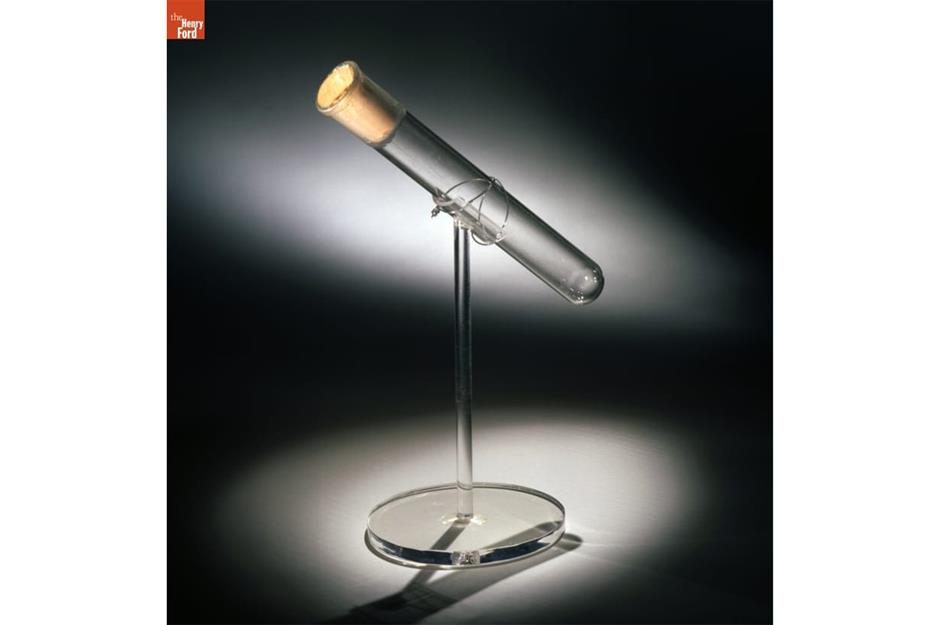
Tucked away in the back of the Henry Ford Museum of Innovation in Dearborn, you’ll spot an unassuming test tube in a red glass case – our choice for the most eccentric attraction in the US. The sealed test tube is said to hold Thomas Edison's dying breath, captured by Edison’s son Charles on the request of Henry Ford.
Ford once worked at the Edison Illuminating Company and struck up life-long friendship with the inventor. He also dabbled in reanimation and spiritualism, and hoped that by capturing the breath he would also capture Edison’s soul as it escaped his body.
Now discover more unusual things you'll find on a US road trip
Comments
Do you want to comment on this article? You need to be signed in for this feature